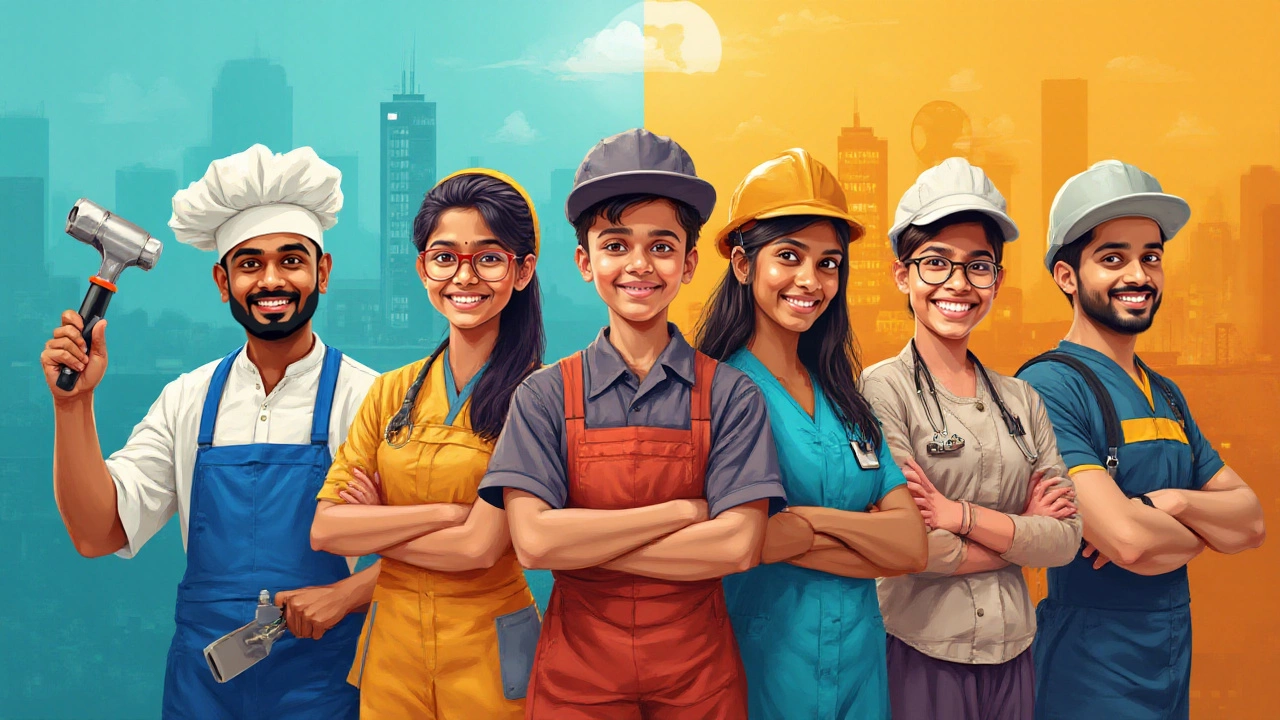Vocational Courses Explained: Skills, Careers, and Real-World Benefits
 Aug, 2 2025
Aug, 2 2025
Imagine skipping endless theory and walking straight into a job with skills that matter. That's what vocational courses are all about. These aren't just backup plans for students who hate textbooks. Actually, the world is starting to rely on vocational training more than ever, with half of all jobs worldwide requiring specialized skills you won’t get in a typical classroom. Here’s the surprising part: In some European countries like Germany, more teenagers choose vocational routes than academic ones. Maybe it’s time to rethink what school means to success.
What Is a Vocational Course?
Vocational courses go by many names: technical education, career training, trade school, the list goes on. At their core, these programs teach you how to do a specific job well, fast. No need to bury your head in endless essays or memorize history dates unless you plan on being a historian. Instead, you learn practical stuff that employers actually want. Think of a chef cooking in a busy kitchen, a plumber fixing a leaking pipe, or a video game designer building levels—these are all people trained through vocational courses.
Here’s a little secret most people miss. The term "vocational" comes from the Latin word "vocatio," meaning calling. So, these courses are about more than just making a living; they’re about finding your thing and turning it into a real career, often in less time than a traditional college degree. For example, you could earn a diploma in auto mechanics in a year or become a certified electrician in less than two. Some programs start right after class 10 or 12, while others are for adults figuring out fresh career moves. You pick what matches your interest, and before you know it, you’re ready to start earning—or even running your own business.
Vocational courses are split into two big groups. First, you have trade-based programs like welding, carpentry, and fashion designing, which involve plenty of hands-on training. Then there are service-oriented fields such as hotel management, healthcare support, and digital marketing. The course content? It’s built around practical skills, workplace experience (like internships or apprenticeships), and often a job placement guarantee. Some vocational schools even set up mock offices or workshops to copy the real deal.
Worried about recognition? Relax. In places like India, the National Skill Development Corporation (NSDC) and sector skill councils make sure these courses meet real-world standards. Globally, organizations like the International Labour Organization (ILO) push for high-quality vocational training because it bridges the gap between education and what companies actually need.
When you finish, you often walk away with a certificate or diploma recognized by employers big and small. In fact, many vocational grads land jobs faster than traditional degree holders, especially in hands-on industries. Here’s something to chew on: According to a 2023 survey by the Confederation of Indian Industry, 66% of employers said practical skills matter more than classroom grades for many jobs. That puts vocational grads a notch above when it comes to real-world hiring.

Why Choose a Vocational Course?
Let’s be honest—nobody wants to slog through four years of university if a good job is waiting just a year down the line. Vocational courses are the shortcut (the smart, legal kind). They’re perfect for people who like learning by doing, not just reading. If you get a kick out of fixing things, building, creating, or caring, you’ll fit right in. And since you learn on the job, it’s way easier to find work that sticks.
The cost factor’s another game changer. Four years at a private college can bury you in debt. Vocational programs? They usually charge a fraction of that price. Plus, the duration is short. You’re working—and earning—while your friends are still wrestling with assignments and exams.
But don’t think vocational jobs only mean blue overalls or standing on shop floors. Modern vocational training opens doors to high-demand, well-paying careers. Tech support specialists, graphic designers, radiology technicians, even digital marketers get their head starts from these programs. Some of today’s most famous personalities—think Gordon Ramsay (chef), Steve Jobs (product designer), or Jamie Oliver (cook)—learned their trades outside of traditional colleges.
Vocational course options are also super flexible. Some offer night classes for people who work during the day. Others run online, letting you train anywhere there’s WiFi. In countries like Australia, more than 30% of high school grads choose this path. In the US, nearly one out of five college-age adults enroll in career and technical education each year.
| Country | % of Students in Vocational Education | Popular Vocational Fields |
|---|---|---|
| Germany | 48% | Engineering, IT, Automotives |
| India | 21% | Healthcare, IT Support, Engineering |
| Australia | 33% | Hospitality, Trades, Agriculture |
| USA | 19% | Healthcare, Construction, Technology |
Here’s something wild: By 2030, the International Labour Organization predicts that more than 45% of new jobs will require skills you only get through vocational courses or apprenticeships. The world’s biggest economies aren’t just talking about college degrees anymore; they want people who can work with their hands and brains together.
If you’re someone who likes to stay ahead of the game, vocational education could make you recession-proof. Skilled workers like HVAC technicians, nurses, or 3D printing specialists face way less job insecurity—even in tough times—because their skills are always in demand. It’s no wonder that in countries like Switzerland and Singapore, the government actively encourages kids to pick up a trade alongside traditional schooling.
Not sure where to start? Here are three quick tips: First, look for schools accredited by government bodies or industry groups—they’ll set you up for success. Second, chat with people already working in the field you want. Third, check job sites and newspapers to see which skills are hot in your area. If you like the idea of fast-tracking your career, you’re exactly the sort of person these courses were made for.

How to Pick the Right Vocational Course for You
This is the fun part—and honestly, it’s where most people trip up. With choices ranging from culinary arts to cybersecurity, you have to know what excites you. A smart move is to make a list of things you enjoy, things you’re good at, and jobs you see yourself doing. The trick is matching your interests with industries that are actually hiring. For example, tech skills like coding or electrician training are pretty much future-proof. Nearly every city and town in India, the US, Europe—you name it—needs people who can install, fix, or build things right now.
Job security is a big deal, so look at growth stats. Healthcare workers (like medical lab assistants or dental hygienists) face massive shortages across Asia, Africa, and North America. IT and digital marketing? Companies keep creating jobs faster than they can fill them. For creative souls, fields like animation, graphic design, or audio engineering aren’t just options—they’re solid career bets. Here’s an insider tip: If the government is offering free or subsidized courses in a certain area, that usually means there’s a demand wave coming.
Once you’ve narrowed down a field or two, dig into schools or programs with a good reputation. That means checking reviews, talking to past students, and making sure the institute has ties to employers. In India, top names like the Industrial Training Institutes (ITIs), Polytechnics, and sector-specific academies are a solid bet. If you’re eyeing healthcare or IT, many online platforms now partner with brands like Google, Coursera, or TATA to certify courses. If you want hands-on work abroad, look for programs that offer internationally recognized certificates, like City & Guilds or the German Dual Training System.
Here’s where things get a bit more personal. Are you the type who wants to start small and work your way up? Short courses—like a three-month bakery certificate or a six-month digital marketing bootcamp—help you test the waters. But if you know you’ve found your passion, you might splash out with a two-year diploma and specialize further. There’s no one-size-fits-all. Your path can be as unique as you are.
One last thing—a lot of students worry about social pressure. Maybe your neighbours or aunties push for a big-name college degree. But the job market is quietly changing. Big companies like Siemens, Infosys, Hilton Hotels, and even Google now hire people with strong vocational backgrounds. Some roles pay just as much, or more, than “desk jobs” that require bachelors’ degrees.
If you want to boost your career odds, keep a close eye on government training and placement schemes. Programs like India’s PMKVY (Pradhan Mantri Kaushal Vikas Yojana) or Singapore’s SkillsFuture have helped millions get job-ready. Many of these courses include paid apprenticeships, letting you earn as soon as you learn. Globally, internships and hands-on learning still beat theory any day, and companies love seeing real work experience on a resume.
So if you’re searching for a fast, flexible, and practical way to a good job—or just love learning skills that put you in demand—a vocational course could easily be your secret weapon. It’s the shortest line between ambition and a paycheck.